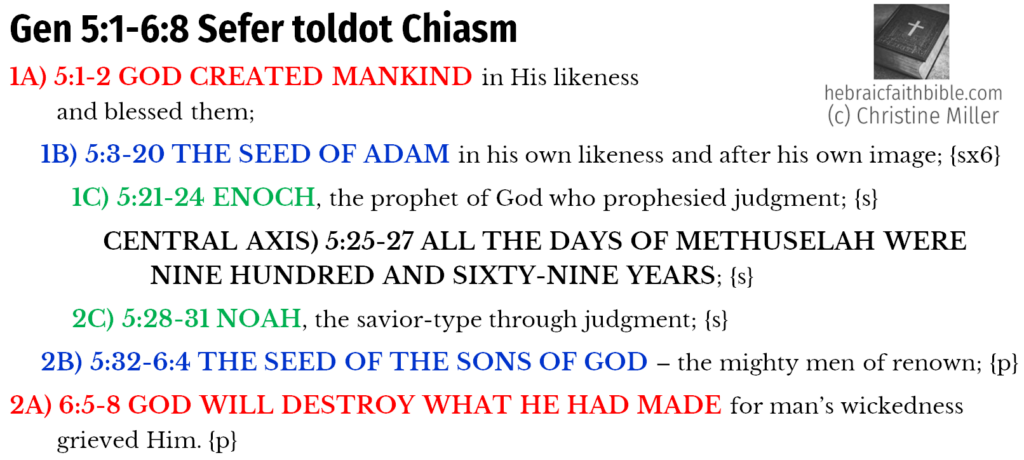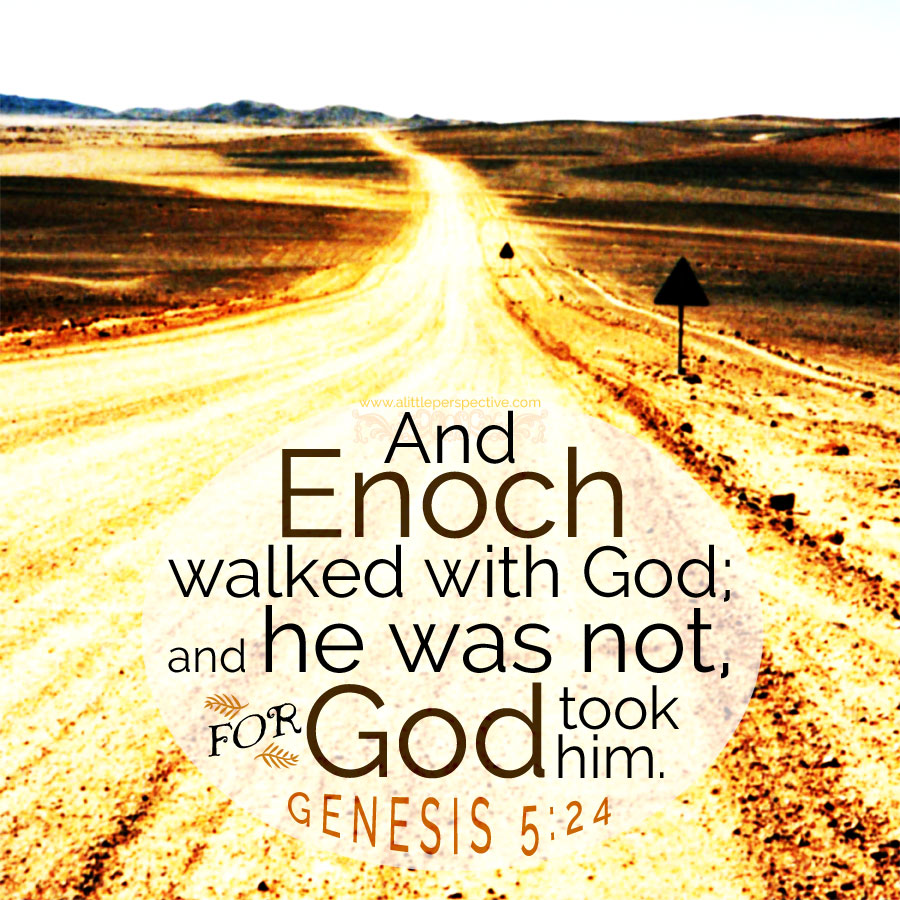Read Genesis 5:1-6:8 at Bible Gateway.
The teaching tools of scripture
Gen 1:1-2:3 and the teaching tools of scripture part one and part two
Gen 1:1-6:8 and finding the topic themes of scripture
Hebrew paragraph divisions
5:1-5 {s} Mortality of Adam
5:6-8 {s} Mortality of Seth
5:9-11 {s} Mortality of Enosh
5:12-14 {s} Mortality of Kenan
5:15-17 {s} Mortality of Mahalalel
5:18-20 {s} Mortality of Jared
5:21-24 {s} Enoch walked with God and did not die
5:25-27 {s} Mortality of Methuselah
5:28-31 {s} Mortality of Lamech
5:32-6:4 {p} The Holy Spirit will not strive with flesh forever
6:5-8 {p} Exile from the earth is the consequence of sin, but Noah found grace in the eyes of YHVH
Strong themes of the parashah
3:22-6:4 {sx11+p} Exile and death follows from walking with flesh; but life follows from walking with YHVH
6:5-8 {p} Exile from the earth is the consequence of sin, but Noah found grace in the eyes of YHVH
Gen 5:1-6:8 Chiastic structure

Download the fully expanded Gen 5:1-6:8 Sefer toldot chiasm pdf (Coming …).
Why is the central axis the detail about the length of Methuselah’s life? Enoch had prophesied that a judgment by water would come, and when Methuselah was born, he so named him, because it means, “his death will bring.” In the year that Methuselah died, in other words, the judgment by water will come. Now Methuselah is the longest-lived person in the Scriptures. The judgment was delayed because God has always been merciful and longsuffering, not wishing that any should perish!
Theme of the parashah
The consequence of sin = exile and death/ The consequence of walking with YHVH = grace and life.
Finding Messiah in Sefer toldot
Here the Gospel is presented in Genesis, not only overtly in the history of Enoch and Noah, for the man who walked with God did not die, and the man who found grace in the eyes of YHVH did not perish in the judgment; but also covertly as a second witness. Notice that the names of the first ten patriarchs before the Flood tell the prophecy of God’s plan of salvation in Messiah.
5:1-5 {s} The mortality of Adam (his name means “man”)
5:6-8 {s} The mortality of Seth (his name means “appointed”)
5:9-11 {s} The mortality of Enosh (“mortality”)
5:12-14 {s} The mortality of Kenan (“possessed of sorrow”)
5:15-17 {s} The mortality of Mahalalel (“praise of God”)
5:18-20 {s} The mortality of Jared (“descend”)
5:21-24 {s} Enoch walked with God and did not die (“teaching”)
5:25-27 {s} The mortality of Methuselah (“his death shall bring”)
5:28-31 {s} The mortality of Lamech (“despairing”) / the birth of Noah (“comfort, rest”)
“Man is appointed mortality possessed of sorrow, but the blessed God shall descend, teaching; and His death shall bring the despairing, comfort and rest.”
Additional readings for this parashah
Psa 4 (my notes) | Isa 29:22-30:18 (my notes) | Mat 23 (my notes)
Studies in Sefer toldot
Gen 5, Bible for Beginners
Gen 6, Bible for Beginners
Gen 5 and 6, Enoch walked with God
Gen 5:1-5, The mortality of Adam
Gen 5:21-24, Halak, “walk,” from the ancient Hebrew pictographs
Gen 5:1-31, The comfort-bringer
Gen 5:32-6:4, The Sons of God
Gen 6:5-8, “I will blot out man” and Noah’s grace
The big picture of Sefer toldot prophesies of the Feast of Unleavened Bread
Further study off-site
Did people like Adam and Noah really live over 900 years?
Are there gaps in the Genesis genealogies?
The genealogy to Noah reveals the gospel
Who were the Nephilim?
Nephilim and demons in the book of Enoch
Grace – Hebrew word study
Answers about Noah’s Ark
SCRIPTURE REVEALED SERIES by CHRISTINE MILLER:
THE LAW of LOVE | FINDING MESSIAH in TORAH | GENESIS in CHIASTIC STRUCTURE

















Leave a Reply